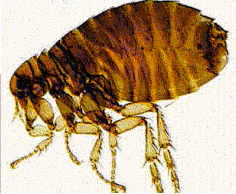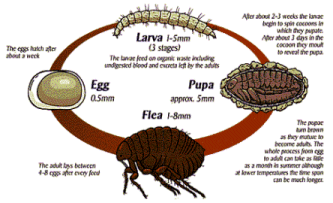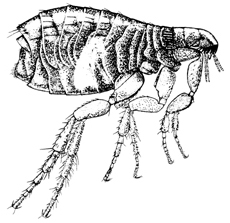|
HOME |
|


|
HOME |
|


When you drop a flea from two metres high, it does not die because the cat flea has an extremely strong exoskeleton and it is lightweight. Heavily armored plates protect its body parts. The head structure of the flea allows it to move through fur easily. The exoskeleton is waterproof, shock resistant and able to survive high pressure.
In order for the cat flea to get its food (blood), it punctures the skin to suck blood. The flea's eyes are not very useful but its antennae helps the flea detect movement and shapes. The antennae is what eyes are to us. The flea's thorax and abdomen have claws to hold on to its host.
JUMPING

5... 4... 3... 2... 1... Liftoff, that's the countdown for a space shuttle leaving the Earth. The flea when jumping accelerates 50 times faster than a space shuttle. Although fleas cannot fly, they can jump over 15cm high and 35cm long, that is about one hundred and fifty times its own length. Without its outer shell it would get smashed by the speed of the jump, and especially on its landing. Fleas have a well built body for jumping. Did you know that if fleas were the size of humans, they would be able to jump over the St. Paul's Cathedral in London six hundred times for three days without getting tired!

Fleas pass through a complete life cycle of four stages from eggs, larva, pupa, adult. The eggs are small and white. The complete life cycle from egg to adult varies from two weeks to eight months. Generally, after two days to two weeks the eggs hatch into larva.

Larvae are blind, avoid light, and take a week to several months to fully develop. They pass through three larval stages. Their food source consists of digested blood from adult flea feces, dead skin, hair, feathers, and organic debris. Pupa mature to adulthood within a cocoon woven by the larva. Dust, pet hair, carpet fibers, and other debris stick to this cocoon. After about five to fourteen days adult fleas emerge from the cocoon.

The alarm clock that awakens the adult flea may include the detection of vibration of pet or human movement, pressure, heat, noise, or carbon dioxide (a potential blood meal). Female fleas lay up to twenty eggs per day and six-hundred in a lifetime.
Although fleas can live up to two months or one year without eating, they cannot survive or lay eggs without blood. Newly emerged adult fleas live only about one week if they don't get a blood meal.